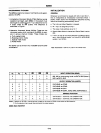
8259A
POLL
In
this mode the microprocessor internal Interrupt
Enable flip-flop
Is
reset, disabling its interrupt input.
Service to devices is achieved
by
programmer Initiative
using a Poll command.
The
Poll command Is Issued
by
setting
P=
"1"
in
OCW3.
The
8259A
treats the next
AD
pulse
to
the
8259A
(i.e.,
RD
=
0,
~
=
0)
as
an
interrupt acknowledge, sets the
appropriate
IS
bit If there is a request,
and
reads the
priority
level. Interrupt is frozen from
WR
to
RD.
The word enabled onto the data bus during
m5
is:
07
De
05
o.
03 02
01
00
1
I W2
WI
wol
WO-W2:
Binary code of
the
highest priority level
requesting service.
I:
Equal to a
"1"
if
there is
an
interrupt.
This mode
Is
useful
if
there is a routine command com·
mon to several levels
so
that the
fNTA
sequence is not
needed (saves
ROM
space). Another application is to
use the
poll mode to expand the number of priority
levels to more than
64.
END
OF
INTERRUPT
(EOI)
The
In
Service
(IS)
bit can
be
reset either automatically
following the trailing edge
of
the last in sequence INTA
pulse (when
AEOI
bit in
ICW1
is set) or
by
a command
word that must
be
issued to the 8259A before returning
from a service routine
(EOI
command).
An
EOI
command
must
be
issued twice, once for the master
and
once for
the corresponding slave
if
slaves
are
in use.
There are two forms of
EOI
command: Specific
and
Non·
Specific. When the
8259A
Is
operated in modes which
preserve the
fully nested structure,
it
can
determine
which
IS
bit to reset on
EOL
When
a Non-Specific
EOI
command is issued the
8259A
will automatically reset
the highest
IS
bit of those that
are
set, since in the
nested mode the highest
IS
level was necessarily the
last level acknowledged and serviced.
However, when a mode is used which
may
disturb the
fully nested structure, the
8259A
may no longer
be
able
to determine the last level acknowledged.
In
this case a
Specific
End
of Interrupt
(SEOI)
must
be
issued which
Includes
as
part
of
the command the
IS
level to
be
reset.
EOI
is
issued whenever
EOI
=
1,
in
OCW2,
where
LO-L2
is
the binary
level
of the
IS
bit to
be
reset.
Note that although
the Rotate command
can
be
issued together with
an
EOI
where
EOI
=
1,
it
is
not necessarily tied to it.
It should
be
noted that
an
IS
bit that is masked
by
an
IMR
bit will not
be
cleared
by
a non·specific
EOI
if the
8259A
Is in the Special Mask
Mode.
AUTOMATIC
END
OF
INTERRUPT (AEOI) MODE
If
AEOI
= 1
In
ICW4,
then the
8259A
will operate in
AEOI
mode continuously until reprogrammed
by
ICW4.
In
this
mode the
8259A
will automatically perform a non·
specific
EOI
operation
at
the trailing edge of the last
interrupt acknowledge pulse (third pulse in
MCS·80/85,
second in
MCS·86).
Note that from a system standpoint,
this mode should
be
used only when a nested multilevel
interrupt structure is not required within a single 8259A.
To
achieve automatic rotation (Rotate Mode
A)
within
AEOI,
there is a special rotate flip-flop. It is set by
OCW2
with R =
1,
SEOI
=
0,
EOI
=
0,
and
cleared with R =
0,
SEOI
=
0,
EOI
=
O.
ROTATING
PRIORITY
MODE A (AUTOMATIC
ROTATION)
FOR
EQUAL
PRIORITY
DEVICES
In
some applications there
are
a number of interrupting
devices of equal priority.
In
this mode a device, after
being serviced, receives the lowest priority, so a device
requesting
an
interrupt will
have
to wait, in the worst
case until each of
7 other devices are serviced
at
most
once. For example,
if
the priority
and
"in
service" status
is:
Before
Rotate
(IR4
the highest priority requiring service)
IS7
lSI
ISS
IS.
IS3
152
IS1
ISO
"IS"
Status
10111011101010101
Priority Status
Low
••
1 Priority Hlgh
••
1 Prlorlly
1
716
1 5 I • I 3 1 2 I
ho
I
After Rotate
(IR4
was serviced, all other priorities
rotated correspondingly)
IS7
lSI
ISS
IS.
IS3 IS2
151
ISO
"IS"
Slatus
10111010101010101
Priority Status
Hlgh.1I
Prlorlly
1 2 1
11
0
Low
••
t Prlorlly
7E04131
The
Rotate command mode A
is
issued
in
OCW2
where:
R
=
1.
EOI
=
1.
SEOI
=
O.
Internal status
is
updated by
an
End
of Interrupt I
EOI
or AEOII command. If R =
1,
EOI
=
0,
SEOI
=
0,
a "Rotate-A" flip-flop
is
set.
This
is
useful in
AEOI,
and
described under Automatic
End
of Interrupt.
ROTATING
PRIORITY
MODE
B (ROTATION
BY
SOFTWARE)
The
programmer can change priorities by programming
the bottom priority and thus fixing
all other priorities;
i.e.,
if
IR5
is programmed
as
the bottom priority device,
then
IR6
will
have
the highest one.
The
Rotate command is issued in
OCW2
where: R =
1,
SEOI
=
1;
LO-
L2
is the binary priority level code of the
bottom priority device.
Observe that
In
this mode internal status is updated by
software
control during
OCW2.
However,
it
is independ-
ent
of
the
End
of Interrupt
(EOI)
command (also exe·
cuted by
OCW2).
Priority changes can
be
executed
duro
ing
an
EOI
command or independently.
9-49


















